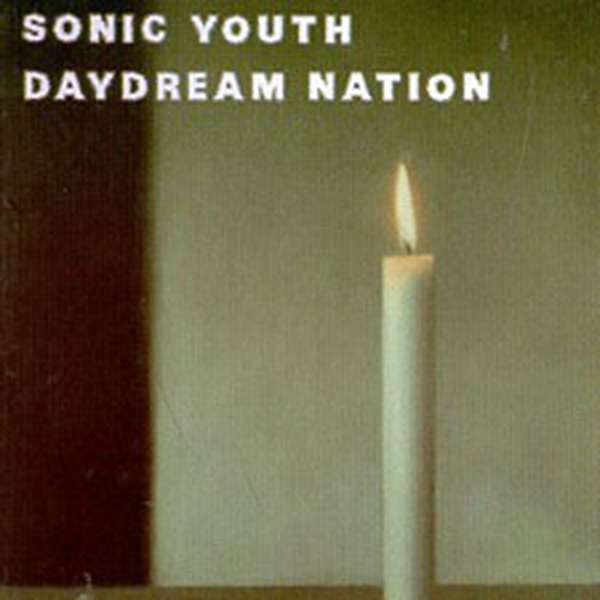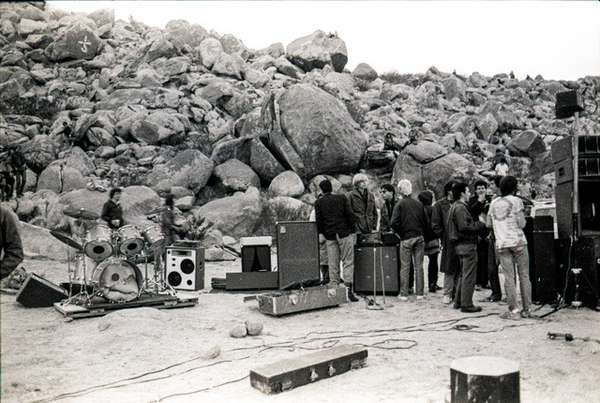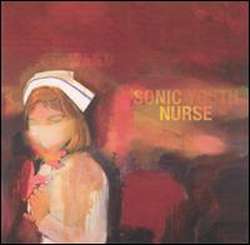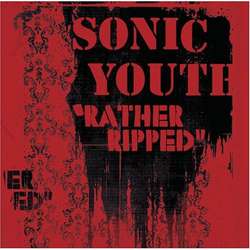When I first heard Sonic Youth, I didn't know about their formidable New York hipster cachet: Glenn Branca confederates, initially hated by Village Voice snob Bob Christgau, ex-No New York alumni (at least before Steve Shelley got behind the skins), etc. I had no idea that this was the band that bridged hardcore and the downtown gallery scene - how many punk bands get written up in Artforum? (Don't answer that.) And at the time, I probably couldn't have cared less what a bunch of turtleneck'd gallery patrons thought.
And I still don't. Because the fact of the matter is the band's much-heralded early efforts were valuable but ultimately dead end excursions into post-PiL NYC downtown turmoil, like chopping through the bush only to reach a sheer precipice. People have been jerking off over No Wave more and more in the last few years, but in the final analysis it looks like most other attempts to shoehorn the logic of the art gallery into rock and roll: easy to lionize if you're got an agenda, but not very listenable unless you're into self-deception.
But even at the beginning, Sonic Youth already had a boatload of great ideas that put them head and shoulders over their downtown contemporaries - most notably their aesthetic of taking pawnshop guitars and rebuilding them into alternately tuned, inter-dimensional weapons lethal at 300 yards. But their boho art-rock rocketship really took off into the stratosphere when they applied their advanced guitechnology to writing some really fucking good songs. (Note that Swans also followed this same path, ultimately harnessing their fascistic stomp "n grind for more subtle and rewarding purposes.)
Sonic Youth became great because from the start they grasped an important truth that today's crop of "experimental" poseurs seem incapable of apprehending: experimentation is a means, not an end. Like Mike Azerrad has sagely noted, you can (or at least, Moore/Ranaldo could) Frankenstein a guitar until it sounds like church bells, but if you've got nowhere to go with it, all the bell tolling in the world won't save you from mediocrity.
And that's why Daydream Nation is such a stunner - good God, the songs! Song after sweeping, majestic, breezy, creepy, crawly, crazy, brain-bending, blown-out, gorgeous song. It comes out sounding like Americana from a world where America existed only as a half-forgotten, post-apocalyptic memory. The Gordon/Shelley rhythm corps sounds like a heartbeat or a pulse, while Ranaldo and Moore shoot fireworks across the street at each other from the rooftops. They still rage off into the wilderness occasionally - see the middles of "Silver Rocket" and "Total Trash" - but now it's for a higher purpose, and it works because of the contrast. Don't get me started talking about the end of "The Sprawl", or "Providence" (even the album's most experimental song ends up being profoundly affecting; the prettiest sad song this side of Low), or the harmonics in "Trilogy," because I'll be here all damn day.
Even the lyrics to this album are great, spinning New York-smart references to cultural fixtures like cyberpunk maven William Gibson ("The Sprawl") and Andy Warhol's Chelsea Girls ("Eric's Trip"). But the lyrics also sync up seamlessly with the music, so that even if you miss the references the words still sing.
Few albums deserve this deluxe, 2CD treatment more. Daydream Nation is the highwater mark of Sonic Youth's long and rewarding career, and a watershed moment for American underground music as a whole. Before this, Sonic Youth, like Big Black and others (the bands Christgau dubbed "pigfuck"), had dabbled in exploring the dark underbelly of American life but with Daydream Nation they produced a genuine piece of Americana, which in 2006 was even added to the Library of Congress' National Recording Registry, a collection of recordings that are "culturally, historically, or aesthetically important, and/or inform or reflect life in the United States." Sonic Youth now rubs shoulders with Scott Joplin's ragtime piano rolls and William Faulkner's West Point Military Academy address (fellow New Yorker Grandmaster Flash is in there too).
The liner notes of this reissue feature an essay from former Forced Exposure scribe and tastemaker Byron Coley, and another by band compatriot Ray Farrell. With all due respect to Farrell, Coley's writing is by far the more interesting of the two, featuring his erudite and incisive musings on the album's creation. The highlight of his essay is a comic exegesis of the album's lyrics, juxtaposing his own interpretation against the stated meanings ascribed by the band themselves. While Moore, Gordon, et al spin their references to authors and artists, Coley constructs a referential web revealing the album's overriding concept as substance abuse, especially of the most unlikely substance: alcohol.
Coley also posits the album as the band's last "fully New York album", and Lee Ranaldo affirms his analysis with an explanation of the aforementioned Americana mode the album operates in: "The records up to and including Daydream were all about growing into a very American thing"¦the bands we were into were all American and they really sounded that way." The tour following the release of the album thrust Sonic Youth out into the world, allowing them to assimilate obscure new influences (like Japanese kinfolk the Boredoms and Masonna), making them less "provincial" (Ranaldo's term) than they had been. (Who'd ever have thought Sonic Youth would be described as provincial? Don't answer that.)
The second disc of this deluxe edition features live renditions of Daydream's songs, plus a handful of covers. The live recordings are frenzied and spirited if only somewhat revelatory: "Candle" and "Teen Age Riot" stick close to the album versions, while the hardcore genetic material in "Cross the Breeze" and "Eric's Trip" is more apparent than ever in the live arena (recall Shelley's origins in Lansing-based agitpropsters The Crucifucks). "Total Trash" (performed as an instrumental) shambles even more than the album version, and Moore dedicates "Silver Rocket" to Andy Warhol and injects a little Darby Crash snarl into his vocals on the chorus.
The covers follow in a similar mode: highly enjoyable, but not a scales falling on the road to Damascus kind of thing. The best is probably the band's take on the Beatles' (really just George Harrison's) stoned harmonium meditation, "Within You Without You," which they run through their own guitarmonium drone. "Touch Me I'm Sick" is fairly straight-faced, with Kim Gordon's lead vocal eschewing the kind of macho deconstruction that a lesser art-conscious band might have inflicted on Mudhoney's growling anthem. They sift Neil Young's "Computer Age" out of his much-maligned Trans LP, hotwiring some organic rock energy into its icy information age façade. And there's a fairly faithful take on Captain Beefheart's "Electricity," although some of the original's paranoid mania is paved over with the cold smoothness of Ranaldo's vocal. (The best extra track is Ranaldo's demo version of "Eric's Trip", just him alone in his apartment with a guitar - that one is fairly revelatory.)
The greatest virtue of the liner notes and extra songs is to provide context, allowing the listener to assimilate the backdrops and influences that went into the creation of a record that transcends its original time and place. The bonus material of the reissue re-establishes some of the roots of these magisterial guitar epics in weird cultural soil like New York's crack epidemic, Denis Johnson's novels and Slayer's South of Heaven album. (Dinosaur Jr. also casts a long shadow over this album, with "Teen Age Riot" famously conceptualized as an alternate U.S. history with laconic mouthpiece/guitar hero J. Mascis installed as president; Dinosaur's Bug came out the same month as Daydream.) It gives you a new perspective on an old favorite, which is exactly the point of a reissue.
And there's a reason the bonus songs aren't particularly eye opening: the album itself is the real revelation, even after all these years. The remaster is subtle but effective, adding muscle to Shelley's drums and Gordon's bass, and more weirdly gorgeous nuance on Moore and Ranaldo's guitar impressionism. The album sounds punchier and clearer, like some of the mud (possibly borrowed from J. Mascis) has been vacuumed out of its sediment pool.
Daydream Nation launched Sonic Youth out of the glorious ghetto of America's fertile underground and onto the world stage, where they still reside today. But this album remains their signature work, the product of a ferociously imaginative band at the height of their powers. And it hasn't aged a day in almost twenty years.
"We're off the streets now / Back up the road, on the riot trail."



